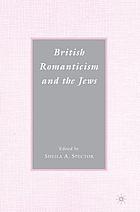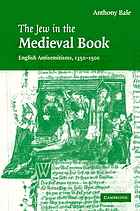
Although much scholarship on Judaism and literature focuses on Jewishness as an ethnic category, a number of titles attend both to Jews as religious writers and to the religious significance of Jews in Christian culture. Susan L. Einbinder’s Beautiful Death: Jewish Poetry and Martyrdom in Medieval France, examining martyrological texts produced between the late eleventh and the thirteenth centuries, demonstrates how shifting evocations of martyrdom attempted to reconsolidate the Jewish community in the face of threats ranging from conversion to Crusades. Notably, she insists that these poems actively appropriated from and engaged with contemporary Christian texts, both sacred and profane, instead of emerging from a hermetically sealed Jewish tradition.
Einbinder’s interest in the intersections of Jewish and Christian literary practice also animates scholarship on more recent periods, as in the work of one of the most active scholars in the area of Judaism and Romantic literature, Sheila Spector. Of interest here are her three edited collections, British Romanticism and the Jews: History, Culture, Literature; The Jews and British Romanticism: Politics, Religion, Culture; and Romanticism/Judaica: A Convergence of Cultures. All three collections analyze how both Jewish authors and Jewish subjects shaped Romantic poetics, fiction, philosophy, and theology, treating authors such as Grace Aguilar, Isaac D’Israeli, Hyman Hurwitz, and Emma Lyon.
Heidi Kaufman’s English Origins, Jewish Discourse, and the Nineteenth-Century Novel is explicitly not interested in Jewish characters, but, rather, in the ways that Jewish history, allusions to the Tanakh and the Talmud, and the like affect how novelists construct “Englishness.” As her title suggests, Jews exist both inside and outside popular notions of English national identity, simultaneously integral to Christian belief yet permanently alien to the nation itself. And Judith Page’s Imperfect Sympathies: Jews and Judaism in British Romantic Literature and Culture puts Christian (or at least non-Jewish) authors in dialogue with lesser-known Jewish writers like Hyman Hurwitz and Judith Montefiore, showing how few Christians could fully imagine how to integrate Jews into British national affections, even when they actively sought to bring Jews within the reach of sympathetic discourse.
One of the most heated topics in modern Jewish culture, both in the United States and abroad, is the danger (or, alternatively, the possibilities) of cultural assimilation. Maurice Samuels offers a case study in the range of religious responses to post-emancipation life in Inventing the Israelite: Jewish Fiction in Nineteenth-Century France, which recovers the fiction of (mostly forgotten) midcentury writers to analyze how they attempt to reimagine Jewishness in the face of French attitudes to citizenship and rapid historical change. Noting that even authors who called their fellow Jews back to orthodoxy were still deeply “modern,” Samuels argues that these figures saw themselves contributing to the moral and cultural renewal of both Jewish and French national life. Nora L. Rubel’s Doubting the Devout: The Ultra-Orthodox in the Jewish-American Imagination links the growing Jewish interest in representing the Haredim in fiction and film to tensions within the Jewish American community over the meaning of orthodoxy, the question of assimilation and acculturation, and the possibility of gender egalitarianism.
Examining novelists from a variety of Jewish backgrounds—secular to ex-Haredi—Rubel finds them imagining Haredi women’s liberation into alternative forms of Jewish faith, critiquing gendered violence against Haredi women and children, and worrying about Haredi plots to steal children from non-observant (or even Modern Orthodox) Jews. By contrast, Yoel Finkelman’s sociological study Strictly Kosher Reading: Popular Literature and the Condition of Contemporary Orthodoxy takes on a distinctly underserved area of contemporary Jewish literature: Haredi texts, which here range from pop theology to thrillers. Finkelman, a Modern Orthodox Jew, studies how Haredi authors, who imagine their community in terms of cultural purity, nevertheless construct their culture by appropriating concepts from the modern Anglophone culture (e.g., self-help, marriage for love) that they claim to reject. These anxieties about assimilation recur in Hana Wirth-Nesher’s Call It English: The Languages of Jewish-American Literature, which analyzes the intersections of religion and the secular in the traces—sometimes overt, sometimes occluded—of Yiddish and Hebrew in Anglophone Jewish American literature. Although such multilingualism is a standard feature of ethnic literatures, Wirth-Nesher concedes, she argues for Jewish difference on the grounds of Hebrew’s verbal and visual differences, in particular, as well as the specific religious associations of its pronunciation.
Much recent scholarship on anti-Semitism has focused, understandably, on the explicitly race-based, “scientific” model introduced in the late nineteenth century. However, scholars continue to pursue its explicitly religious ramifications. Thus, Anthony Bale’s important The Jew in the Medieval Book: English Antisemitisms, 1350-1500 articulates the significance of Jews for medieval literature and theology after their expulsion in 1290. Emphasizing the role of anti-Semitism in shaping Christian theology and self-awareness, Bale tracks it through four iterations: the legend of the Jew of Tewkesbury, who fell into a latrine on the Sabbath and therefore refused to be assisted out (“bad” readings of Scriptural injunctions); the Marian miracles of “boy singers” murdered by Jews (debates over miracles and devotions); the cult of Robert of Bury, another boy supposedly murdered by Jews (masculinity and purity); and the Arma Christi (new modes of spiritual devotion and meditation emphasizing the agonies of Christ). Medieval tropes recur in Carol Margaret Davison’s Anti-Semitism and British Gothic Literature, which traces the construction of two key anti-Semitic tropes: the Wandering Jew and the “Crypto-Jew” (the converted or otherwise concealed Jew). Both figures come together in the figure of the Jewish/Judaized vampire, particularly Dracula: the vampire literalizes older myths, such as the Blood Libel, and suggests the dangerous possibility that the nation could be undermined from within by invisible, life-draining forces.
 British Romanticism and the Jews: History, culture, literature by
British Romanticism and the Jews: History, culture, literature by  The Jew in the medieval book: English antisemitisms, 1350-1500 by
The Jew in the medieval book: English antisemitisms, 1350-1500 by